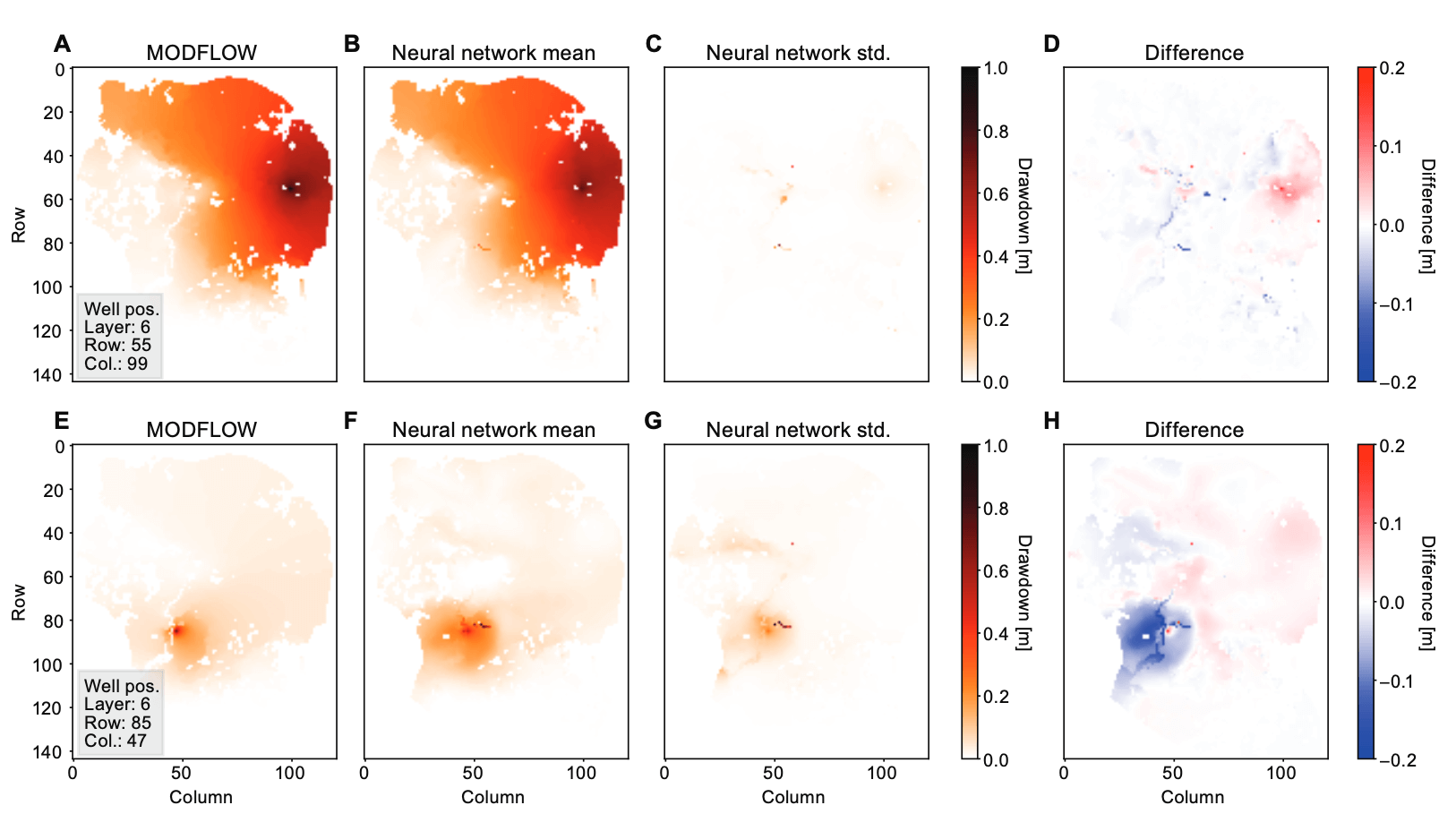
How to Cite
Share
Abstract
Results from numerical simulations play a vital role in the decision process of everyday groundwater management. However, these simulations can be time-consuming for large-scale investigations, and it can be necessary to apply approximate methods instead. This study investigates the abilities of a neural network to replicate simulated drawdown from groundwater abstraction in a numerical groundwater model of the Egebjerg catchment, Denmark. We follow a generalised methodology that uses the information within the deterministic numerical model to create a training set for the neural network to learn from and extend the method to work in a 3D Danish groundwater model case. We compare the abilities of the trained neural network with the results of conventional computations in terms of speed and accuracy and argue that this approach has the potential to improve decision support for decision-makers within groundwater management.
How to Cite
Share
Copyright (c) 2023 Mathias Busk Dahl, Troels Norvin Vilhelmsen, Trine Enemark, Thomas Mejer Hansen

This work is licensed under a Creative Commons Attribution 4.0 International License.
Supplementary Files
Downloads
An annual collection of articles submitted to GEUS Bulletin and published throughout 2023. Published online only. This issue is open until the end of 2023.
Cover photo: satellite image is from the European Space Agency’s Copernicus Sentinel data 2023, as featured in Karlsson et al. 2023: A data set of monthly [...]
References
- Abadi, M. et al. 2016: Tensorflow: Large-scale machine learning on heterogeneous distributed systems. arXiv preprint arXiv:1603.04467. https://doi.org/10.48550/arXiv.1603.04467
- Belitz, K. & Stackelberg, P.E. 2021: Evaluation of six methods for correcting bias in estimates from ensemble tree machine learning regression models. Environmental Modelling & Software 139, 105006. https://doi.org/10.1016/j.envsoft.2021.105006
- Dahl, M.B., Vilhelmsen, T.N., Bach, T. & Hansen, T.M. 2023: Hydraulic head change predictions in groundwater models using a probabilistic neural network. Frontiers in Water 5. https://doi.org/10.3389/frwa.2023.1028922
- Dillon, J.V. et al. 2017: Tensorflow distributions. arXiv preprint arXiv:1711.10604. https://doi.org/10.48550/arXiv.1711.10604
- Enemark, T., Andersen, L.T., Høyer, A.-S., Jensen, K.H., Kidmose, J., Sandersen, P.B.E. & Sonnenborg, T.O. 2022: The influence of layer and voxel geological modelling strategy on groundwater modelling results. Hydrogeology Journal 30(2), 617–635. https://doi.org/10.1007/s10040-021-02442-9
- Furtney, J. 2021: Scikit-fmm: The fast marching method for Python. https://github.com/scikit-fmm/scikit-fmm (accessed June 2023).
- Gardner, M.W. & Dorling, S.R. 1998: Artificial neural networks (the multilayer perceptron) – A review of applications in the atmospheric sciences. Atmospheric Environment 32, 2627–2636. https://doi.org/10.1016/S1352-2310(97)00447-0
- Gorelick, S.M. 1983: A review of distributed parameter groundwater management modeling methods. Water Resources Research 19, 305–319. https://doi.org/10.1029/WR019i002p00305
- Green, T.R., Taniguchi, M., Kooi, H., Gurdak, J.J., Allen, D.M., Hiscock, K.M., Treidel, H. & Aureli, A. 2011: Beneath the surface of global change: Impacts of climate change on groundwater. Journal of Hydrology 405(3), 532–560. https://doi.org/10.1016/j.jhydrol.2011.05.002
- Hadded, R., Nouiri, I., Alshihabi, O., Mamann, J., Huber, M., Laghouane, A., Yahiaoui, H. & Tarhouni, J. 2013: A decision support system to manage the groundwater of the Zeuss Koutine Aquifer using the WEAP-MODFLOW framework. Water Resources Management 27, 1981–2000. https://doi.org/10.1007/s11269-013-0266-7
- Harbaugh, A.W. 2005: MODFLOW-2005, The U.S. Geological Survey modular ground-water model — the ground-water flow process: U.S. Geological Survey Techniques and Methods 6-A16. USGS. https://doi.org/10.3133/tm6A16
- Hendrycks, D. & Gimpel, K. 2016: Gaussian error linear units (gelus). arXiv preprint arXiv:1606.08415. https://doi.org/10.48550/arXiv.1606.08415
- Kingma, D.P. & Ba, J. 2014: Adam: A method for stochastic optimization. arXiv preprint arXiv:1412.6980. https://doi.org/10.48550/arXiv.1412.6980
- Johnson, J.M. & Khoshgoftaar, T.M. 2019: Survey on deep learning with class imbalance. Journal of Big Data 6(1), 27. https://doi.org/10.1186/s40537-019-0192-5
- Kingma, D.P. & Ba, J. 2014: Adam: A method for stochastic optimization. arXiv Preprint arXiv:1412.6980.
- Langevin, C.D., Hughes, J.D., Banta, E.R., Niswonger, R.G., Panday, S. & Provost, A.M. 2017: Documentation for the MODFLOW 6 Groundwater Flow Model. Report. U.S. Geological Survey Techniques and Methods 6-A55. http://pubs.er.usgs.gov/publication/tm6A55 (accessed June 2023).
- Langevin, C., Hughes, J., Banta, E., Provost, A., Niswonger, R. & Panday, S. 2019: MODFLOW 6 Modular Hydrologic Model Version 6.1.0. U.S. Geological Survey Software. https://doi.org/10.5066/F76Q1VQV
- Pisinaras, V., Petalas, C., Tsihrintzis, V.A. & Zagana, E. 2007: A groundwater flow model for water resources management in the Ismarida plain, North Greece. Environmental Modeling & Assessment 12(2), 75–89. https://doi.org/10.1007/s10666-006-9040-z
- Thibaut, R., Laloy, E. & Hermans, T. 2021: A new framework for experimental design using Bayesian Evidential Learning: The case of well-head protection area. Journal of Hydrology 603, 126903. https://doi.org/10.1016/j.jhydrol.2021.126903









